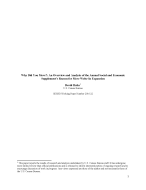Why Did You Move?: An Overview and Analysis of the Annual Social and Economic Supplement’s Reason for Move Write-In Expansion
Why Did You Move?: An Overview and Analysis of the Annual Social and Economic Supplement’s Reason for Move Write-In Expansion
Notes added 07/02/2019
Please see the revised user note about the reason for move write-in expansion for updated information and corrections.
For more information about other changes and potential issues related to the reason for moving data (especially about potential differences between the 2015 and 2016 data discussed in this working paper), please see the CPS-ASEC Geographic Mobility User Notes.
CPS-ASEC Geographic Mobility User Notes
-
Migration/Geographic Mobility User NotesUser notes give caution, discuss weighting and estimation, explain variables, and so on.
-
User NotesASEC User Note: Potential Display Issue, Reason for Move: 2012-2015A potential display issue in the data collection instrument could have introduced response bias during the 2012-2015 CPS-ASEC data collection.
Introduction
The reason for move question, what was (name’s) main reason for moving, has been asked on the Annual Social and Economic Supplement (ASEC) of the Current Population Survey (CPS) continuously since 1998. There are currently 19 individual reason for move choices, including change in marital status, new job or job transfer, wanted cheaper housing, and natural disaster.
This paper concentrates on three of these individual reasons: other family, other job-related, and other housing. These responses provide a general sense of why the respondent moved, however, they lack any degree of specificity. This is particularly concerning because the percentage of movers selecting one of these three reasons has reached as high as 31 percent. Because these reasons are broad in scope, migration analysts have limited insight into why movers selected them. The reason for move write-in expansion addresses this by collecting additional information for movers who select other family, other job-related, or other housing by asking them to specify their exact reason for move through write-in fields. This provides migration analysts with the opportunity to evaluate and enhance the response categories offered on the survey.
This working paper documents the reason for move write-in expansion, which was implemented in the 2016 ASEC. This is accomplished by describing the various elements of the expansion, including who was impacted, how the write-in coding procedure changed, and how the edits changed. Justifications for adopting the expansion are provided, including an example based on a response being created from write-in responses. This paper concludes with an analysis of results from the 2016 ASEC. Common responses in each of the four “other” categories are provided, along with a general idea of how often cases are changed by coding.




